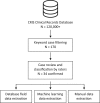Cognitive neuropsychiatric analysis of an additional large Capgras delusion case series
- PMID: 30794090
- PMCID: PMC6425915
- DOI: 10.1080/13546805.2019.1584098
Cognitive neuropsychiatric analysis of an additional large Capgras delusion case series
Abstract
Introduction: Although important to cognitive neuropsychiatry and theories of delusions, Capgras delusion has largely been reported in single case studies. Bell et al. [2017. Uncovering Capgras delusion using a large scale medical records database. British Journal of Psychiatry Open, 3(4), 179-185] previously deployed computational and clinical case identification on a large-scale medical records database to report a case series of 84 individuals with Capgras delusion. We replicated this approach on a new database from a different mental health service provider while additionally examining instances of violence, given previous claims that Capgras is a forensic risk.
Methods: We identified 34 additional cases of Capgras. Delusion phenomenology, clinical characteristics, and presence of lesions detected by neuroimaging were extracted.
Results: Although most cases involved misidentification of family members or partners, a notable minority (20.6%) included the misidentification of others. Capgras typically did not present as a monothematic delusion. Few cases had identifiable lesions with no evidence of right-hemisphere bias. There was no evidence of physical violence associated with Capgras.
Conclusions: Findings closely replicate Bell et al. (2017). The majority of Capgras delusion phenomenology conforms to the "dual route" model although a significant minority of cases cannot be explained by this framework.
Keywords: Delusional misidentification; forensic; neuropsychiatry; psychosis; schizophrenia.
Figures
Similar articles
-
Mental illness, violence and delusional misidentifications: the role of Capgras' syndrome in matricide.J Forensic Leg Med. 2014 Jan;21:9-13. doi: 10.1016/j.jflm.2013.10.012. Epub 2013 Nov 1. J Forensic Leg Med. 2014. PMID: 24365679
-
[Capgras delusion: a review of aetiological theories].Rev Neurol. 2010 Apr 1;50(7):420-30. Rev Neurol. 2010. PMID: 20387212 Review. Spanish.
-
Towards a unified, yet pluralistic, account of Capgras' delusion.Cogn Neuropsychiatry. 2024 Nov;29(6):323-341. doi: 10.1080/13546805.2025.2451266. Epub 2025 Jan 19. Cogn Neuropsychiatry. 2024. PMID: 39829084
-
Capgras' Delusion: A Systematic Review of 255 Published Cases.Psychopathology. 2019;52(3):161-173. doi: 10.1159/000500474. Epub 2019 Jul 19. Psychopathology. 2019. PMID: 31326968
-
[Capgras symptom associated parricides. 2 case reports].Orv Hetil. 2019 Oct;160(42):1673-1676. doi: 10.1556/650.2019.31476. Orv Hetil. 2019. PMID: 31608690 Hungarian.
Cited by
-
Beyond the Imposter: Deciphering Capgras Syndrome and Multidisciplinary Management.Case Rep Psychiatry. 2025 Aug 11;2025:5541100. doi: 10.1155/crps/5541100. eCollection 2025. Case Rep Psychiatry. 2025. PMID: 40831473 Free PMC article.
-
A Somatic-Type Delusional Disorder Resulted in Severe Weight Loss With a Body Mass Index of 10.2: A Case Report.Cureus. 2024 Mar 15;16(3):e56217. doi: 10.7759/cureus.56217. eCollection 2024 Mar. Cureus. 2024. PMID: 38618312 Free PMC article.
-
Delusional Themes are More Varied Than Previously Assumed: A Comprehensive Systematic Review and Meta-Analysis.Schizophr Bull. 2025 May 8;51(3):637-645. doi: 10.1093/schbul/sbae225. Schizophr Bull. 2025. PMID: 39847500 Free PMC article.
References
-
- Bauer R. M. (1984). Autonomic recognition of names and faces in prosopagnosia: A neuropsychological application of the guilty knowledge test. Neuropsychologia, 22(4), 457–469. - PubMed
-
- Bell V., Halligan P. W., & Ellis H. D. (2006). Explaining delusions: A cognitive perspective. Trends in Cognitive Sciences, 10(5), 219–226. - PubMed
-
- Berson R. J. (1983). Capgras’ syndrome. American Journal of Psychiatry, 140(8), 969–978. - PubMed
Publication types
MeSH terms
Grants and funding
LinkOut - more resources
Full Text Sources

